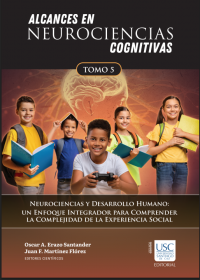Alcances en neurociencias cognitivas - Tomo V. Neurociencias y Desarrollo Humano: Un Enfoque Integrador para Comprender la Complejidad de la Experiencia Social
PlumX
Palabras clave:
Neuropsicología, Neurodesarrollo, Neurociencias cognitivas, Neuropsychology, neurodevelopment, cognitive neuroscienceSinopsis
La línea de investigación en cognición, cerebro y aprendizaje del grupo de investigación, calidad de vida -CAVIDA- de la Escuela de Ciencias Sociales y Humanas de la Universidad Pontificia Bolivariana, y la línea en neurociencias y neurodesarrollo del grupo de investigación en Fonoaudiología y Psicología de la Facultad de Salud de la Universidad Santiago de Cali, presentan a la comunidad académica y científica el tomo cinco del libro Alcances en Neurociencias Cognitivas. Un espacio creado para la conversación, reflexión y debate de las ideas en torno el paradigma de las neurociencias cognitivas y su aplicabilidad en diferentes campos disciplinares y laborales.En esta edición, el equipo editorial ha integrado seis capítulos que pretenden definir planteamientos comprensivos en problemáticas del desarrollo enfocados en fenómenos del trastorno por déficit de atención e hiperactividad, trastornos de la conducta y aprendizaje de un segundo idioma, y de forma atrevida pero cuidando el respeto hacia el lector, se han integrado tres productos que buscan plantear modelos paradigmáticos con objetivos interventivos de problemáticas sociales y con implicaciones en videojuegos, mejoramiento escolar y la cognición social.
Capítulos
-
Descifrando el TDAH: Rutas Multiómicas y Neuropsicológicas desde la Infancia hasta la Adultez
-
Sobre los Trastornos del Comportamiento Disruptivo, Control de los Impulsos y la Conducta (Revisión Narrativa)
-
Relación entre la Conciencia Fonológica en Primera Lengua y la Comprensión y Producción de Vocabulario en Segunda Lengua de Estudiantes Preescolares de Inglés en Colombia
-
BrainCraft: Creando un Videojuego para Cultura de Paz y Evaluación Cognitiva
-
Modelos para el Mejoramiento del Control Inhibitorio, Regulación Emocional y Conductual en Niños en Condición de Riesgo y Vulnerabilidad (Revisión de Literatura)2
-
Una Aproximación Semiótica al Desarrollo de la Cognición Social: Agencialidad y Transiciones en el Contexto Escolar Colombiano
Descargas
Citas
Aarts, E., Ederveen, T. H. A., Naaijen, J., Zwiers, M. P., Boekhorst, J., Timmerman, H. M., Smeekens, S. P., Netea, M. G., Buitelaar, J. K., Franke, B., Van Hijum, S. A. F. T., & Vasquez, A. A. (2017). Gut microbiome in ADHD and its relation to neural reward anticipation. PLOS ONE, 12(9), 1–17. https://doi.org/10.1371/JOURNAL.PONE.0183509
Afman, L., & Müller, M. (2006). Nutrigenomics: From Molecular Nutrition to Prevention of Disease. Journal of the American Dietetic Association, 106(4), 569–576. https://doi.org/10.1016/J.JADA.2006.01.001
Akkaya, C., Karadag, M., Hangul, Z., Sahin, E., & Isbilen, E. (2023). Evaluation of the Regulatory Role of Circadian Rhythm Related Long Non-Coding RNAs in ADHD Etiogenesis. Journal of Attention Disorders, 27(2), 201–213. https://doi.org/10.1177/10870547221130113
Álamo, C., López-Muñoz, F., & Sánchez-García, J. (2016). Mechanism of action of guanfacine: a postsynaptic differential approach to the treatment of attention deficit hyperactivity disorder (ADHD). Actas Españolas de Psiquiatría, 44(3), 107–112. https://actaspsiquiatria.es/index.php/actas/article/view/913
Azeredo, A., Moreira, D., & Barbosa, F. (2018). ADHD, CD, and ODD: Systematic review of genetic and environmental risk factors. Research in Developmental Disabilities, 82, 10–19. https://doi.org/10.1016/J.RIDD.2017.12.010
Cervantes-Henríquez, M. L., Acosta-López, J. E., Martínez-Banfi, M. L., Vélez, J. I., Mejía-Segura, E., Lozano-Gutiérrez, S. G., Sánchez-Rojas, M., Zurbarán, M. A., Zurek, E. E., Arcos-Burgos, M., Pineda, D. A., & Puentes-Rozo, P. J. (2020). ADHD Endophenotypes in Caribbean Families. Journal of Attention Disorders, 24(14), 2100–2114. https://doi.org/10.1177/1087054718763741
Checa-Ros, A., Jeréz-Calero, A., Molina-Carballo, A., Campoy, C., & Muñoz-Hoyos, A. (2021). Current Evidence on the Role of the Gut Microbiome in ADHD Pathophysiology and Therapeutic Implications. Nutrients, 13(1), 249. https://doi.org/10.3390/NU13010249
Cubillo, A., Halari, R., Smith, A., Taylor, E., & Rubia, K. (2012). A review of fronto-striatal and fronto-cortical brain abnormalities in children and adults with Attention Deficit Hyperactivity Disorder (ADHD) and new evidence for dysfunction in adults with ADHD during motivation and attention. Cortex, 48(2), 194–215. https://doi.org/10.1016/J.CORTEX.2011.04.007
Demontis, D., Walters, G. B., Athanasiadis, G., Walters, R., Therrien, K., Nielsen, T. T., Farajzadeh, L., Voloudakis, G., Bendl, J., Zeng, B., Zhang, W., Grove, J., Als, T. D., Duan, J., Satterstrom, F. K., Bybjerg-Grauholm, J., Bækved-Hansen, M., Gudmundsson, O. O., Magnusson, S. H., … Børglum, A. D. (2023). Genome-wide analyses of ADHD identify 27 risk loci, refine the genetic architecture and implicate several cognitive domains. Nature Genetics, 55(2), 198–208. https://doi.org/10.1038/s41588-022-01285-8
Faraone, S. V., & Buitelaar, J. (2010). Comparing the efficacy of stimulants for ADHD in children and adolescents using meta-analysis. European Child and Adolescent Psychiatry, 19(4), 353–364. https://doi.org/10.1007/S00787-009-0054-3
Faraone, S. V, Larsson, • Henrik, & Org, S. (2018). Genetics of attention deficit hyperactivity disorder. Molecular Psychiatry, 24(4), 562–575. https://doi.org/10.1038/s41380-018-0070-0
Faraone, S. V., & Larsson, H. (2019). Genetics of attention deficit hyperactivity disorder. Molecular Psychiatry, 24(4), 562–575. https://doi.org/10.1038/S41380-018-0070-0
Franke, B., Faraone, S. V., Asherson, P., Buitelaar, J., Bau, C. H. D., Ramos-Quiroga, J. A., Mick, E., Grevet, E. H., Johansson, S., Haavik, J., Lesch, K. P., Cormand, B., & Reif, A. (2011). The genetics of attention deficit/hyperactivity disorder in adults, a review. Molecular Psychiatry, 17(10), 960–987. https://doi.org/10.1038/mp.2011.138
Garzón Rodríguez, N., Briceño-Balcázar, I., Díaz-Barrera, L. E., Nicolini, H., Genis-Mendoza, A. D., Flores-Lázaro, J. C., & Quiroz-Padilla, M. F. (2023). Moderating effects of impulsivity and morning cortisol on the genotype-phenotype relationship of attention deficit hyperactivity disorder in young adults. Stress and Health, 40(2), 1–8. https://doi.org/10.1002/SMI.3308
Garzón Rodríguez, N., Briceño-Balcázar, I., Nicolini, H., MartínezMagaña, J. J., Genis-Mendoza, A. D., Flores-Lázaro, J. C.,Villatoro Velázquez, J. A., Bustos Gamiño, M., Medina-Mora,M. E., & Quiroz-Padilla, M. F. (2024). Exploring the relationship between admixture and genetic susceptibility to attention deficit hyperactivity disorder in two Latin American cohorts. Journal of Human Genetics, 1–8. https://doi.org/10.1038/s10038-024-01246-5
Gillies, D., Sinn, J. K. H., Lad, S. S., Leach, M. J., & Ross, M. J. (2012). Polyunsaturated fatty acids (PUFA) for attention deficit hyperactivity disorder (ADHD) in children and adolescents. The Cochrane Database of Systematic Reviews, 2012(7). https://doi.org/10.1002/14651858.CD007986.PUB2
Groen-Blokhuis, M. M., Middeldorp, C. M., Kan, K. J., Abdellaoui, A., Van Beijsterveldt, C. E. M., Ehli, E. A., Davies, G. E., Scheet, P. A., Xiao, X., Hudziak, J. J., Hottenga, J. J., Neale, B. M., & Boomsma,D. I. (2014). Attention-Deficit/Hyperactivity Disorder Polygenic Risk Scores Predict Attention Problems in a Population-Based Sample of Children. Journal of the American Academy of Child & Adolescent Psychiatry, 53(10), 1123-1129. https://doi.org/10.1016/J.JAAC.2014.06.014
Han, J. Y., Kwon, H. J., Ha, M., Paik, K. C., Lim, M. H., Lee, S. G., Yoo, S. J., & Kim, E. J. (2015).
The effects of prenatal exposure to alcohol and environmental tobacco smoke on risk for ADHD: A large population-based study. Psychiatry Research, 225(1–2), 164–168.
https://doi.org/10.1016/j.psychres.2014.11.009
Hubers, N., Hagenbeek, F. A., Pool, R., Déjean, S., Harms, A. C., Roetman, P. J., van Beijsterveldt, C. E. M., Fanos, V., Ehli, E. A., Vermeiren, R. R. J. M., Bartels, M., Hottenga, J. J., Hankemeier, T., van Dongen, J., & Boomsma, D. I. (2024).
Integrative multiomics analysis of genomic, epigenomic, and metabolomic data leads to new insights for ADHD. American Journal of Medical Genetics Part B: Neuropsychiatric Genetics, 195(2).
https://doi.org/10.1002/ajmg.b.32955
Joseph, N., Zhang-James, Y., Perl, A., & Faraone, S. V. (2015).
Oxidative stress and ADHD: A meta-analysis. Journal of Attention Disorders, 19(11), 915–924.
https://doi.org/10.1177/1087054713510354
Lau, C. H. E., Siskos, A. P., Maitre, L., Robinson, O., Athersuch, T. J., Want, E. J., Urquiza, J., Casas, M., Vafeiadi, M., Roumeliotaki, T., McEachan, R. R. C., Azad, R., Haug, L. S., Meltzer, H. M., Andrusaityte, S., Petraviciene, I., Grazuleviciene, R., Thomsen, C., Wright, J., … Coen, M. (2018).
Determinants of the urinary and serum metabolome in children from six European populations. BMC Medicine, 16(1).
https://doi.org/10.1186/s12916-018-1190-8
Li, M., Francis, E., Hinkle, S. N., Ajjarapu, A. S., & Zhang, C. (2019). Preconception and Prenatal Nutrition and Neurodevelopmental Disorders: A Systematic Review and MetaAnalysis. Nutrients, 11(7), 1628.
https://doi.org/10.3390/nu11071628
Loe, I. M., & Feldman, H. M. (2007).
Academic and Educational Outcomes of Children With ADHD. Journal of Pediatric Psychology, 32(6), 643–654.
https://doi.org/10.1093/jpepsy/jsl054
Luciano, M., Davies, G., Summers, K. M., Hill, W. D., Clarke, T. K., Shirali, M., Harris, S. E., Marioni, R. E., McIntosh, A. M., & Deary, I. J. (2018).
Single nucleotide polymorphisms associated with reading ability show connection to general cognition and mathematical aptitude. Science Advances, 4(9), eaar8032.
https://doi.org/10.1126/sciadv.aar8032
Luo, Y., Weibman, D., Halperin, J. M., & Li, X. (2019).
A Review of Heterogeneity in Attention Deficit/Hyperactivity Disorder (ADHD). Frontiers in Human Neuroscience, 13, 42.
https://doi.org/10.3389/fnhum.2019.00042
Martins-Silva, T., Paixão-Côrtes, V. R., Hutz, M. H., Rohde, L. A., Genro, J. P., Polanczyk, G. V., & Salatino-Oliveira, A. (2018).
Biological pathways associated with attention-deficit/hyperactivity disorder and other psychiatric disorders. European Child & Adolescent Psychiatry, 28(10), 1331–1341.
https://doi.org/10.1007/s00787-018-01270-0
Masi, G., Milone, A., Manfredi, A., Pari, C., Paziente, A., Millepiedi, S., & Muratori, F. (2021).
Comorbidity of attention-deficit/hyperactivity disorder and generalized anxiety disorder in children and adolescents: Impact on psychopathology and treatment response. CNS Spectrums, 26(2), 173–181.
https://doi.org/10.1017/S1092852920000076
Meier, S. M., & Dalsgaard, S. (2018).
ADHD and increased risk of developing depression. Nature Reviews Neurology, 14(9), 513–514.
https://doi.org/10.1038/s41582-018-0047-8
Merzon, E., Manor, I., Rotem, A., Schneider, T., Vinker, S., & Cohen, A. G. (2021). ADHD as a risk factor for infection with COVID-19. Journal of Attention Disorders, 25(13), 1783–1790.
https://doi.org/10.1177/1087054720943271
Meyer, B. M., Rabl, U., Bublak, P., Gmeindl, L., Buchheim, A., & Winker, R. (2023). Dysregulation of emotional attention in ADHD: A systematic review and meta-analysis of event-related potentials. Neuroscience & Biobehavioral Reviews, 150, 105216.
https://doi.org/10.1016/j.neubiorev.2023.105216
Molina, B. S. G., & Pelham, W. E. (2014). Attention-deficit/hyperactivity disorder and risk of substance use disorder: Developmental considerations, potential pathways, and opportunities for research. Annual Review of Clinical Psychology, 10, 607–639.
https://doi.org/10.1146/annurev-clinpsy-032813-153722
Mulligan, A., Anney, R. J. L., O'Regan, M., Chen, W., Butler, L., Fitzgerald, M., & Gill, M. (2009).
Autism symptoms in Attention-Deficit/Hyperactivity Disorder: A familial trait which correlates with conduct, oppositional defiant, language and motor disorders. Journal of Autism and Developmental Disorders, 39(2), 197–209.
https://doi.org/10.1007/s10803-008-0621-3
Musser, E. D., Galloway-Long, H. S., Frick, P. J., & Nigg, J. T. (2013).
Emotion regulation and heterogeneity in attention-deficit/hyperactivity disorder. Journal of the American Academy of Child & Adolescent Psychiatry, 52(2), 163–171.
https://doi.org/10.1016/j.jaac.2012.11.009
Nigg, J. T. (2017).
Annual Research Review: On the relations among self-regulation, self-control, executive functioning, effortful control, cognitive control, impulsivity, risk-taking, and inhibition for developmental psychopathology. Journal of Child Psychology and Psychiatry, 58(4), 361–383.
https://doi.org/10.1111/jcpp.12675
Oades, R. D. (2018).
An exploration of the associations between serotonin and dopamine genes and symptoms of ADHD in adults and children. Behavioral and Brain Functions, 14(1), 9.
https://doi.org/10.1186/s12993-018-0144-7
Pérez, A., Rodríguez, M., Martínez, L., Díaz, G., & Quiroga, J. (2020).
Neuropsychological profiles in children with ADHD: A cross-sectional study. Revista de Neurología, 70(6), 199–206.
https://doi.org/10.33588/rn.7006.2019424
Polanczyk, G. V., Salum, G. A., Sugaya, L. S., Caye, A., & Rohde, L. A. (2015).
Annual Research Review: A meta-analysis of the worldwide prevalence of mental disorders in children and adolescents. Journal of Child Psychology and Psychiatry, 56(3), 345–365.
https://doi.org/10.1111/jcpp.12381
Posner, J., Polanczyk, G. V., & Sonuga-Barke, E. (2020).
Attention-deficit hyperactivity disorder. The Lancet, 395(10222), 450–462.
https://doi.org/10.1016/S0140-6736(19)33004-1
Rasmussen, P., & Gillberg, C. (2000).
Natural outcome of ADHD with developmental coordination disorder at age 22 years: A controlled, longitudinal, community-based study. Journal of the American Academy of Child & Adolescent Psychiatry, 39(11), 1424–1431.
https://doi.org/10.1097/00004583-200011000-00017
Reimherr, F. W., Marchant, B. K., Gift, T. E., Steans, T. A., Wender, P. H., & Reimherr, M. L. (2017).
Emotional dysregulation in adult ADHD and response to atomoxetine. Journal of Attention Disorders, 21(6), 512–519.
https://doi.org/10.1177/1087054713493327
Rommel, A. S., James, S. N., McLoughlin, G., Brandeis, D., Banaschewski, T., Asherson, P., & Kuntsi, J. (2017).
Association of ADHD symptom trajectories with adolescent academic achievement and adult occupational outcome: A longitudinal study. Journal of Child Psychology and Psychiatry, 58(7), 713–722.
https://doi.org/10.1111/jcpp.12694
Rubia, K. (2018).
Cognitive neuroscience of attention deficit hyperactivity disorder (ADHD) and its clinical translation. Frontiers in Human Neuroscience, 12, 100.
https://doi.org/10.3389/fnhum.2018.00100
Rucklidge, J. J., & Kaplan, B. J. (2014).
Broad-spectrum micronutrient treatment for attention-deficit/hyperactivity disorder: Rationale and evidence to date. CNS Drugs, 28(9), 775–785.
https://doi.org/10.1007/s40263-014-0181-2
Sciberras, E., Mulraney, M., Silva, D., & Coghill, D. (2017).
Prenatal risk factors and the etiology of ADHD—Review of existing evidence. Current Psychiatry Reports, 19(1), 1.
https://doi.org/10.1007/s11920-017-0750-2
Shaw, P., Malek, M., Watson, B., Sharp, W., Evans, A., & Greenstein, D. (2012).
Development of cortical surface area and gyrification in attention-deficit/hyperactivity disorder. Biological Psychiatry, 72(3), 191–197.
https://doi.org/10.1016/j.biopsych.2012.01.031
Smith, A. B., Taylor, E., Brammer, M., Toone, B., & Rubia, K. (2006).
Task-specific hypoactivation in prefrontal and temporoparietal brain regions during motor inhibition and attention allocation in ADHD. Human Brain Mapping, 27(10), 973–989.
https://doi.org/10.1002/hbm.20236
Sonuga-Barke, E. J. S. (2005).
Causal models of attention-deficit/hyperactivity disorder: From common simple deficits to multiple developmental pathways. Biological Psychiatry, 57(11), 1231–1238.
https://doi.org/10.1016/j.biopsych.2004.09.008
Sonuga-Barke, E. J. S., & Halperin, J. M. (2010).
Developmental phenotypes and causal pathways in attention deficit/hyperactivity disorder: Potential targets for early intervention? Journal of Child Psychology and Psychiatry, 51(4), 368–389.
https://doi.org/10.1111/j.1469-7610.2009.02195.x
Stergiakouli, E., Martin, J., Hamshere, M. L., Langley, K., Evans, D. M., St Pourcain, B., Timpson, N. J., O'Donovan, M. C., Thapar, A., & Davey Smith, G. (2015).
Shared genetic influences between attention-deficit/hyperactivity disorder (ADHD) traits in children and clinical ADHD. Journal of the American Academy of Child & Adolescent Psychiatry, 54(4), 322–327.
https://doi.org/10.1016/j.jaac.2015.01.010
Thapar, A., Cooper, M., Eyre, O., & Langley, K. (2013).
What have we learnt about the causes of ADHD? Journal of Child Psychology and Psychiatry, 54(1), 3–16.
https://doi.org/10.1111/j.1469-7610.2012.02611.x
Tistarelli, N., Fagnani, C., Troianiello, M., Stazi, M. A., & Adriani, W. (2020).
The nature and nurture of ADHD and its comorbidities: A narrative review on twin studies. Neuroscience & Biobehavioral Reviews, 109, 63–77.
https://doi.org/10.1016/j.neubiorev.2019.12.027
Vidal-Ribas, P., Brotman, M. A., Valdivieso, I., Leibenluft, E., & Stringaris, A. (2016).
The status of irritability in psychiatry: A conceptual and quantitative review. Journal of the American Academy of Child & Adolescent Psychiatry, 55(7), 556–570.
https://doi.org/10.1016/j.jaac.2016.04.014
Volkow, N. D., Wang, G. J., Kollins, S. H., Wigal, T. L., Newcorn, J. H., Telang, F., Fowler, J. S., Zhu, W., Logan, J., Ma, Y., Pradhan, K., Wong, C., Swanson, J. M. (2009).
Evaluating dopamine reward pathway in ADHD: Clinical implications. JAMA, 302(10), 1084–1091.
https://doi.org/10.1001/jama.2009.1308
Willcutt, E. G. (2012).
The prevalence of DSM-IV attention-deficit/hyperactivity disorder: A meta-analytic review. Neurotherapeutics, 9(3), 490–499.
https://doi.org/10.1007/s13311-012-0135-8
Zhang, L., Chang, S., Li, Z., Zhang, K., Du, Y., & Xu, L. (2016).
Genetic evidence for the association between the dopamine D4 receptor gene and attention-deficit/hyperactivity disorder in a Chinese population. Behavioral and Brain Functions, 12(1), 6.
https://doi.org/10.1186/s12993-016-0096-7
Zhao, X., Lian, J., Chen, L., Zhang, L., & Li, J. (2021).
Gut-brain axis and attention-deficit/hyperactivity disorder: A new perspective for treatment. Frontiers in Psychiatry, 12, 712401.
https://doi.org/10.3389/fpsyt.2021.712401
Zhou, R., & Wang, L. (2020).
ADHD: New perspectives from neuroimaging to treatment. Neuroscience Bulletin, 36(12), 1385–1398.
https://doi.org/10.1007/s12264-020-00586-3
Zhu, Y., Guo, X., Luo, X., Zhang, X., Chen, J., Zhang, J., & Tang, F. (2022).
Altered gut microbiota composition and its potential association with ADHD symptoms in children. Psychiatry Research, 309, 114386.
https://doi.org/10.1016/j.psychres.2022.114386
Adriani, W., & Laviola, G. (2004).
Windows of vulnerability to psychopathology and therapeutic strategy in the adolescent rodent model of ADHD. Neuroscience & Biobehavioral Reviews, 28(6), 547–558.
https://doi.org/10.1016/j.neubiorev.2004.07.006
Akinbami, L. J., Liu, X., Pastor, P. N., & Reuben, C. A. (2011).
Attention deficit hyperactivity disorder among children aged 5–17 years in the United States, 1998–2009. NCHS Data Brief, 70, 1–8.
https://www.cdc.gov/nchs/data/databriefs/db70.pdf
Arnsten, A. F. T. (2009).
Toward a new understanding of attention-deficit hyperactivity disorder pathophysiology: An important role for prefrontal cortex dysfunction. CNS Drugs, 23(Suppl 1), 33–41.
https://doi.org/10.2165/00023210-200923000-00005
Arnsten, A. F. T., Rubia, K. (2012).
Neurobiological circuits regulating attention, cognitive control, motivation, and emotion: Disruptions in neurodevelopmental psychiatric disorders. Journal of the American Academy of Child & Adolescent Psychiatry, 51(4), 356–367.
https://doi.org/10.1016/j.jaac.2012.01.008
Banaschewski, T., Becker, K., Scherag, S., Franke, B., & Coghill, D. (2010).
Molecular genetics of attention-deficit/hyperactivity disorder: An overview. European Child & Adolescent Psychiatry, 19(3), 237–257.
https://doi.org/10.1007/s00787-010-0090-z
Barkley, R. A. (1997).
Behavioral inhibition, sustained attention, and executive functions: Constructing a unifying theory of ADHD. Psychological Bulletin, 121(1), 65–94.
https://doi.org/10.1037/0033-2909.121.1.65
Barkley, R. A., Fischer, M., Smallish, L., & Fletcher, K. (2002).
The persistence of attention-deficit/hyperactivity disorder into young adulthood as a function of reporting source and definition of disorder. Journal of Abnormal Psychology, 111(2), 279–289.
https://doi.org/10.1037/0021-843X.111.2.279
Biederman, J., Petty, C. R., Evans, M., Small, J., & Faraone, S. V. (2010).
How persistent is ADHD? A controlled 10-year follow-up study of boys with ADHD. Psychiatry Research, 177(3), 299–304.
https://doi.org/10.1016/j.psychres.2009.12.010
Biederman, J., Petty, C. R., Woodworth, K. Y., Lomedico, A., Hyder, L. L., & Faraone, S. V. (2012).
Adult outcome of attention-deficit/hyperactivity disorder: A controlled 16-year follow-up study. Journal of Clinical Psychiatry, 73(7), 941–950.
https://doi.org/10.4088/JCP.11m07332
Boonstra, A. M., Oosterlaan, J., Sergeant, J. A., & Buitelaar, J. K. (2005).
Cognitive deficits in adult attention deficit hyperactivity disorder: A meta-analysis of controlled studies. Journal of Neural Transmission, 112(1), 16–26.
https://doi.org/10.1007/s00702-004-0203-4
Börger, N. A., & van der Meere, J. J. (2000).
Motor control and state regulation in children with ADHD: A state regulation deficit hypothesis. Journal of Child Psychology and Psychiatry, 41(11), 1225–1236.
https://doi.org/10.1111/1469-7610.00610
Bush, G. (2010).
Attention-deficit/hyperactivity disorder and attention networks. Neuropsychopharmacology, 35(1), 278–300.
https://doi.org/10.1038/npp.2009.120
Casey, B. J., Tottenham, N., Liston, C., & Durston, S. (2005).
Imaging the developing brain: What have we learned about cognitive development? Trends in Cognitive Sciences, 9(3), 104–110.
https://doi.org/10.1016/j.tics.2005.01.011
Castellanos, F. X., & Proal, E. (2012).
Large-scale brain systems in ADHD: Beyond the prefrontal–striatal model. Trends in Cognitive Sciences, 16(1), 17–26.
https://doi.org/10.1016/j.tics.2011.11.007
Castellanos, F. X., Sonuga-Barke, E. J. S., Milham, M. P., & Tannock, R. (2006).
Characterizing cognition in ADHD: Beyond executive dysfunction. Trends in Cognitive Sciences, 10(3), 117–123.
https://doi.org/10.1016/j.tics.2006.01.011
Coghill, D. R., & Sonuga-Barke, E. J. S. (2012).
Annual Research Review: Categories versus dimensions in the classification and conceptualisation of child and adolescent mental disorders—Implications of recent empirical study. Journal of Child Psychology and Psychiatry, 53(5), 469–489.
https://doi.org/10.1111/j.1469-7610.2011.02438.x
Cortese, S., Kelly, C., Chabernaud, C., Proal, E., Di Martino, A., Milham, M. P., & Castellanos, F. X. (2012).
Toward systems neuroscience of ADHD: A meta-analysis of 55 fMRI studies. American Journal of Psychiatry, 169(10), 1038–1055.
https://doi.org/10.1176/appi.ajp.2012.11101521
Cubillo, A., & Rubia, K. (2010).
Structural and functional brain imaging in adult attention-deficit/hyperactivity disorder. Expert Review of Neurotherapeutics, 10(4), 603–620.
https://doi.org/10.1586/ern.10.4
Döpfner, M., Hautmann, C., Görtz-Dorten, A., Klasen, F., & Ravens-Sieberer, U. (2015).
Long-term course of ADHD symptoms from childhood to early adulthood in a community sample. European Child & Adolescent Psychiatry, 24(6), 665–673.
https://doi.org/10.1007/s00787-014-0621-0
Durston, S., Tottenham, N. T., Thomas, K. M., Davidson, M. C., Eigsti, I. M., Yang, Y., Ulug, A. M., & Casey, B. J. (2003).
Differential patterns of striatal activation in young children with and without ADHD. Biological Psychiatry, 53(10), 871–878.
https://doi.org/10.1016/S0006-3223(02)01904-2
Durston, S., van Belle, J., & de Zeeuw, P. (2011).
Differentiating frontostriatal and frontocerebellar circuits in attention-deficit/hyperactivity disorder. Biological Psychiatry, 69(12), 1178–1184.
https://doi.org/10.1016/j.biopsych.2010.07.037
Fair, D. A., Posner, J., Nagel, B. J., Bathula, D., Dias, T. G. C., Mills, K. L., Blythe, M. S., Giwa, A., Schmitt, C. F., & Nigg, J. T. (2010).
Atypical default network connectivity in youth with attention-deficit/hyperactivity disorder. Biological Psychiatry, 68(12), 1084–1091.
https://doi.org/10.1016/j.biopsych.2010.07.003
Franke, B., Michelini, G., Asherson, P., Banaschewski, T., Bilbow, A., Buitelaar, J. K., Cormand, B., Faraone, S. V., Ginsberg, Y., Haavik, J., & Kuntsi, J. (2018).
Live fast, die young? A review on the developmental trajectories of ADHD across the lifespan. European Neuropsychopharmacology, 28(10), 1059–1088.
https://doi.org/10.1016/j.euroneuro.2018.08.001
Fried, R., Petty, C. R., Surman, C., Reimer, B., Aleardi, M., Martin, J. M., Coughlin, J. F., Biederman, J. (2006).
Characterizing impaired driving in adults with ADHD: A controlled study. Journal of Nervous and Mental Disease, 194(12), 974–981.
https://doi.org/10.1097/01.nmd.0000243771.86874.3c
Gallo, E. F., & Posner, J. (2016).
Cognitive and emotional influences on ADHD symptomatology: A neurodevelopmental perspective. Current Opinion in Behavioral Sciences, 10, 115–121.
https://doi.org/10.1016/j.cobeha.2016.06.006
Haber, S. N., & Knutson, B. (2010). The reward circuit: Linking primate anatomy and human imaging. Neuropsychopharmacology, 35(1), 4–26.
https://doi.org/10.1038/npp.2009.129
Hart, H., Radua, J., Nakao, T., Mataix-Cols, D., & Rubia, K. (2013).
Meta-analysis of functional magnetic resonance imaging studies of inhibition and attention in attention-deficit/hyperactivity disorder: Exploring task-specific, stimulant medication, and age effects. JAMA Psychiatry, 70(2), 185–198.
https://doi.org/10.1001/jamapsychiatry.2013.277
Hawi, Z., Cummins, T. D. R., Tong, J., Johnson, B., Lau, R., Samarrai, W., & Bellgrove, M. A. (2015).
The molecular genetic architecture of attention deficit hyperactivity disorder. Molecular Psychiatry, 20(3), 289–297.
https://doi.org/10.1038/mp.2014.183
Hesslinger, B., Thiel, T., Tebartz van Elst, L., Hennig, J., & Ebert, D. (2002).
Attention-deficit hyperactivity disorder in adults: Brain dysfunction in the prefrontal and anterior cingulate cortex measured by event-related potentials. Psychiatry Research: Neuroimaging, 113(1–2), 1–10.
https://doi.org/10.1016/S0925-4927(02)00059-7
Hoogman, M., Bralten, J., Hibar, D. P., Mennes, M., Zwiers, M. P., Schweren, L. S. J., & Franke, B. (2017).
Subcortical brain volume differences in participants with attention deficit hyperactivity disorder in children and adults: A cross-sectional mega-analysis. The Lancet Psychiatry, 4(4), 310–319.
https://doi.org/10.1016/S2215-0366(17)30049-4
Insel, T., & Cuthbert, B. (2015).
Brain disorders? Precisely. Science, 348(6234), 499–500.
https://doi.org/10.1126/science.aab2358
Jones, R. M., Somandepalli, K., & Bookheimer, S. Y. (2021).
Neuroimaging of inhibitory control and emotion dysregulation in ADHD and its comorbidities. Current Psychiatry Reports, 23(3), 13.
https://doi.org/10.1007/s11920-021-01241-y
Kaufmann, T., Alnæs, D., Doan, N. T., Brandt, C. L., Andreassen, O. A., & Westlye, L. T. (2017).
Delayed stabilization and individualization in connectome development are related to psychiatric disorders. Nature Neuroscience, 20(4), 513–515.
https://doi.org/10.1038/nn.4511
Konrad, K., & Eickhoff, S. B. (2010).
Is the ADHD brain wired differently? A review on structural and functional connectivity in attention deficit hyperactivity disorder. Human Brain Mapping, 31(6), 904–916.
https://doi.org/10.1002/hbm.21058
Kooij, J. J. S., Bijlenga, D., Salerno, L., Jaeschke, R., Bitter, I., Balázs, J., & Asherson, P. (2019).
Updated European Consensus Statement on diagnosis and treatment of adult ADHD. European Psychiatry, 56, 14–34.
https://doi.org/10.1016/j.eurpsy.2018.11.001
Larsson, H., Dilshad, R., Lichtenstein, P., & Barker, E. D. (2011).
Developmental trajectories of DSM-IV symptoms of attention-deficit/hyperactivity disorder: Genetic effects, family risk and associated psychopathology. Journal of Child Psychology and Psychiatry, 52(9), 954–963.
https://doi.org/10.1111/j.1469-7610.2011.02379.x
Levy, F., Hay, D. A., McStephen, M., Wood, C., & Waldman, I. (1997).
Attention-deficit hyperactivity disorder: A category or a continuum? Genetic analysis of a large-scale twin study. Journal of the American Academy of Child & Adolescent Psychiatry, 36(6), 737–744.
https://doi.org/10.1097/00004583-199706000-00009
Liddle, E. B., Hollis, C., Batty, M. J., Groom, M. J., Totman, J. J., Liotti, M., & Liddle, P. F. (2011).
Task-related default mode network modulation and inhibitory control in ADHD: Effects of motivation and methylphenidate. Journal of Child Psychology and Psychiatry, 52(7), 761–771.
https://doi.org/10.1111/j.1469-7610.2010.02333.x
Lim, L., Marquand, A., Cubillo, A. A., Smith, A. B., Chantiluke, K., Simmons, A., & Rubia, K. (2013).
Disorder-specific predictive classification of adolescents with attention deficit hyperactivity disorder (ADHD) relative to autism using structural magnetic resonance imaging. PLoS ONE, 8(5), e63660.
https://doi.org/10.1371/journal.pone.0063660
Liston, C., Malter Cohen, M., Teslovich, T., Levenson, D., & Casey, B. J. (2011).
Atypical prefrontal connectivity in attention-deficit/hyperactivity disorder: Pathway to disease or pathological end point? Biological Psychiatry, 69(12), 1168–1177.
https://doi.org/10.1016/j.biopsych.2011.03.022
Makris, N., Biederman, J., Valera, E. M., Bush, G., Kaiser, J., Kennedy, D. N., & Seidman, L. J. (2007).
Cortical thinning of the attention and executive function networks in adults with attention-deficit/hyperactivity disorder. Cerebral Cortex, 17(6), 1364–1375.
https://doi.org/10.1093/cercor/bhl047
Mattfeld, A. T., Gabrieli, J. D. E., Biederman, J., Spencer, T., Brown, A., Kotte, A., & Whitfield-Gabrieli, S. (2014).
Brain differences between persistent and remitted attention deficit hyperactivity disorder. Brain, 137(9), 2423–2428.
https://doi.org/10.1093/brain/awu137
McCarthy, H., Skokauskas, N., Frodl, T. (2014).
Identifying a consistent pattern of altered brain activation in ADHD: A meta-analysis. Psychological Medicine, 44(4), 869–880.
https://doi.org/10.1017/S0033291713001037
McLoughlin, G., Makeig, S., & Castellanos, F. X. (2014).
White matter integrity and EEG microstructure in ADHD: Linking brain structure and function. Frontiers in Human Neuroscience, 8, 1–13.
https://doi.org/10.3389/fnhum.2014.00071
Mostert, J. C., Hoogman, M., Onnink, A. M. H., van Rooij, D., von Rhein, D., van Hulzen, K. J. E., & Franke, B. (2018).
Similar subgroups based on cognitive performance exist in ADHD and controls. European Neuropsychopharmacology, 28(9), 1023–1034.
https://doi.org/10.1016/j.euroneuro.2018.06.006
Mowinckel, A. M., Alnæs, D., Pedersen, M. L., Ziegler, S., Fredriksen, M., Kaufmann, T., & Westlye, L. T. (2017).
Increased default-mode variability is related to reduced task performance and is evident in adults with ADHD. NeuroImage: Clinical, 16, 369–382.
https://doi.org/10.1016/j.nicl.2017.08.014
Mueller, A., Hong, D. S., Shepard, S., Moore, T., & D'Esposito, M. (2017).
Role of dopamine D2 receptors in attention and inhibitory control. Neuropsychopharmacology, 42(2), 459–467.
https://doi.org/10.1038/npp.2016.179
Nakao, T., Radua, J., Rubia, K., & Mataix-Cols, D. (2011).
Gray matter volume abnormalities in ADHD: Voxel-based meta-analysis exploring the effects of age and stimulant medication. American Journal of Psychiatry, 168(11), 1154–1163.
https://doi.org/10.1176/appi.ajp.2011.11020281
Normand, C. L., Flora, D. B., Toplak, M. E., & Tannock, R. (2012).
Evidence for a general ADHD factor from a longitudinal general population study. Journal of Attention Disorders, 16(7), 590–600.
https://doi.org/10.1177/1087054711416315
Oldehinkel, M., Hartman, C. A., Hoekstra, P. J., Franke, B., & Oosterlaan, J. (2017).
Structural brain alterations in attention-deficit/hyperactivity disorder across the lifespan: A systematic review. Neuroscience & Biobehavioral Reviews, 74, 139–158.
https://doi.org/10.1016/j.neubiorev.2017.01.005
Pievsky, M. A., & McGrath, R. E. (2018).
The neurocognitive profile of attention-deficit/hyperactivity disorder: A review of meta-analyses. Archives of Clinical Neuropsychology, 33(2), 143–157.
https://doi.org/10.1093/arclin/acx055
Plichta, M. M., & Scheres, A. (2014).
Ventral–striatal responsiveness during reward anticipation in ADHD and its relation to trait impulsivity in the healthy population: A meta-analytic review of the fMRI literature. Neuroscience & Biobehavioral Reviews, 38, 125–134.
https://doi.org/10.1016/j.neubiorev.2013.07.012
Pliszka, S. R. (2005).
The neuropsychopharmacology of attention-deficit/hyperactivity disorder. Biological Psychiatry, 57(11), 1385–1390.
https://doi.org/10.1016/j.biopsych.2004.08.026
Proal, E., Reiss, P. T., Klein, R. G., Mannuzza, S., Gotimer, K., Ramos-Olazagasti, M. A., & Castellanos, F. X. (2011).
Brain gray matter deficits at 33-year follow-up in adults with attention-deficit/hyperactivity disorder established in childhood. Archives of General Psychiatry, 68(11), 1122–1134.
https://doi.org/10.1001/archgenpsychiatry.2011.117
Rubia, K., Alegria, A., Brinson, H., & Smith, A. B. (2014).
Brain abnormalities in attention-deficit hyperactivity disorder: A review of structural and functional MRI findings. Current Topics in Behavioral Neurosciences, 16, 155–198.
https://doi.org/10.1007/7854_2013_248
Sagvolden, T., Johansen, E. B., Aase, H., & Russell, V. A. (2005).
A dynamic developmental theory of attention-deficit/hyperactivity disorder (ADHD) predominantly hyperactive/impulsive and combined subtypes. Behavioral and Brain Sciences, 28(3), 397–419.
https://doi.org/10.1017/S0140525X05000075
Serrallach, B., Groß, C., Bernhofs, V., Engelmann, D., Benner, J., Gündert, N., & Seither-Preisler, A. (2016).
Neural biomarkers for dyslexia, ADHD, and ADD in the auditory cortex of children. Frontiers in Neuroscience, 10, 324.
https://doi.org/10.3389/fnins.2016.00324
Shaw, P., Eckstrand, K., Sharp, W., Blumenthal, J., Lerch, J. P., Greenstein, D., & Rapoport, J. L. (2007).
Attention-deficit/hyperactivity disorder is characterized by a delay in cortical maturation. Proceedings of the National Academy of Sciences, 104(49), 19649–19654.
https://doi.org/10.1073/pnas.0707741104
Shaw, P., Malek, M., Watson, B., Greenstein, D., De Rossi, P., & Sharp, W. (2013).
Trajectories of cerebral cortical development in childhood and adolescence and adult attention-deficit/hyperactivity disorder. Biological Psychiatry, 74(8), 599–606.
https://doi.org/10.1016/j.biopsych.2013.04.007
Shiels, K., & Hawk, L. W. (2010).
Self-regulation in ADHD: The role of error processing. Clinical Psychology Review, 30(8), 951–961.
https://doi.org/10.1016/j.cpr.2010.06.010
Silk, T. J., Vance, A., Rinehart, N., Bradshaw, J. L., & Cunnington, R. (2009).
White-matter abnormalities in attention deficit hyperactivity disorder: A diffusion tensor imaging study. Human Brain Mapping, 30(9), 2757–2765.
https://doi.org/10.1002/hbm.20703
Sonuga-Barke, E. J. S. (2002).
Psychological heterogeneity in AD/HD: A dual pathway model of behaviour and cognition. Behavioural Brain Research, 130(1–2), 29–36.
https://doi.org/10.1016/S0166-4328(01)00432-6
Sonuga-Barke, E. J. S., Dalen, L., & Remington, B. (2003).
Do executive deficits and delay aversion make independent contributions to preschool attention-deficit/hyperactivity disorder symptoms? Journal of the American Academy of Child & Adolescent Psychiatry, 42(11), 1335–1342.
https://doi.org/10.1097/00004583-200311000-00014
Spencer, T. J., Biederman, J., & Mick, E. (2007).
Attention-deficit/hyperactivity disorder: Diagnosis, lifespan, comorbidities, and neurobiology. Journal of Pediatric Psychology, 32(6), 631–642.
https://doi.org/10.1093/jpepsy/jsm005
Sripada, C. S., Kessler, D., & Angstadt, M. (2014).
Lag in maturation of the brain’s intrinsic functional architecture in attention-deficit/hyperactivity disorder. Proceedings of the National Academy of Sciences, 111(39), 14259–14264.
https://doi.org/10.1073/pnas.1407787111
Stavropoulos, K. K. M., & Carver, L. J. (2014).
Reward sensitivity and electrophysiological responses to monetary gains and losses in children with and without autism spectrum disorders. Developmental Cognitive Neuroscience, 10, 1–13.
https://doi.org/10.1016/j.dcn.2014.07.007
Stimulant ADHD Medication Effectiveness Group. (2018).
Long-term effects of stimulant medication on growth and cardiovascular function in ADHD. Pediatrics, 142(3), e20180869.
https://doi.org/10.1542/peds.2018-0869
Tamm, L., Narad, M. E., Antonini, T. N., O’Brien, K. M., Hawk, L. W., & Epstein, J. N. (2012).
Reaction time variability in ADHD: A review. Neurotherapeutics, 9(3), 500–508.
https://doi.org/10.1007/s13311-012-0138-5
Tomasi, D., & Volkow, N. D. (2012).
Abnormal functional connectivity in children with attention-deficit/hyperactivity disorder. Biological Psychiatry, 71(5), 443–450.
https://doi.org/10.1016/j.biopsych.2011.11.003
Tripp, G., & Wickens, J. R. (2008).
Research review: Dopamine transfer deficit: A neurobiological theory of altered reinforcement mechanisms in ADHD. Journal of Child Psychology and Psychiatry, 49(7), 691–704.
https://doi.org/10.1111/j.1469-7610.2007.01851.x
Uddin, L. Q., Kelly, A. M. C., Biswal, B. B., Margulies, D. S., Shehzad, Z., Shaw, D., & Milham, M. P. (2008).
Network homogeneity reveals decreased integrity of default-mode network in ADHD. Journal of Neuroscience Methods, 169(1), 249–254.
https://doi.org/10.1016/j.jneumeth.2007.11.031
Vaidya, C. J., & Stollstorff, M. (2008).
Cognitive neuroscience of Attention Deficit Hyperactivity Disorder: Current status and working hypotheses. Developmental Disabilities Research Reviews, 14(4), 261–267.
https://doi.org/10.1002/ddrr.35
van Rooij, D., Hoekstra, P. J., Mennes, M., von Rhein, D., Thissen, A. J. A. M., Heslenfeld, D. J., & Buitelaar, J. K. (2015).
Distinguishing adolescents with ADHD from their unaffected siblings and healthy comparison subjects by neural activation patterns during response inhibition. American Journal of Psychiatry, 172(7), 674–683.
https://doi.org/10.1176/appi.ajp.2015.14060784
Volkow, N. D., Wang, G. J., Fowler, J. S., & Ding, Y. S. (2005).
Imaging the effects of methylphenidate on brain dopamine: New model on its therapeutic actions for attention-deficit/hyperactivity disorder. Biological Psychiatry, 57(11), 1410–1415.
https://doi.org/10.1016/j.biopsych.2004.11.006
Vossel, S., Geng, J. J., & Fink, G. R. (2014).
Dorsal and ventral attention systems: Distinct neural circuits but collaborative roles. Neuroscientist, 20(2), 150–159.
https://doi.org/10.1177/1073858413494269
Willcutt, E. G., Doyle, A. E., Nigg, J. T., Faraone, S. V., & Pennington, B. F. (2005).
Validity of the executive function theory of attention-deficit/hyperactivity disorder: A meta-analytic review. Biological Psychiatry, 57(11), 1336–1346.
https://doi.org/10.1016/j.biopsych.2005.02.006
Wright, L., Lipszyc, J., Dupuis, A., Thayapararajah, S. W., & Schachar, R. (2014).
Response inhibition and psychopathology: A meta-analysis of go/no-go task performance. Journal of Abnormal Psychology, 123(2), 429–439.
https://doi.org/10.1037/a0036295
Yoon, S. Y. R., Jain, U., & Shapiro, C. (2012).
Sleep in attention-deficit/hyperactivity disorder in children and adults: Past, present, and future. Sleep Medicine Reviews, 16(4), 371–388.
https://doi.org/10.1016/j.smrv.2011.07.001
Zwiers, M. P., Blanken, L. M. E., Mous, S. E., van der Lugt, A., Verhulst, F. C., Tiemeier, H., & White, T. (2017).
Structural connectivity of the fronto-parietal attention network in children with attention-deficit/hyperactivity disorder: A probabilistic tractography study. Psychiatry Research: Neuroimaging, 261, 60–66.
https://doi.org/10.1016/j.pscychresns.2017.01.006
Aagaard, L., & Hansen, E. H. (2011).
Adverse drug reactions reported for attention deficit/hyperactivity disorder medications in the pediatric population: Adverse effects of ADHD drugs in children. European Journal of Clinical Pharmacology, 67(1), 165–174.
https://doi.org/10.1007/s00228-010-0969-9
Albert, J., López-Martín, S., Fernández-Jaén, A., & Carretié, L. (2012).
Affective processing in children with attention-deficit/hyperactivity disorder: A neurophysiological study of event-related potentials. Journal of Abnormal Child Psychology, 40(6), 901–913.
https://doi.org/10.1007/s10802-012-9616-2
American Psychiatric Association. (2013).
Diagnostic and statistical manual of mental disorders (5th ed.). Arlington, VA: Author.
https://doi.org/10.1176/appi.books.9780890425596
Anderson, C. M., Polcari, A., Lowen, S. B., Renshaw, P. F., & Teicher, M. H. (2002).
Effects of methylphenidate on functional magnetic resonance imaging blood oxygen level-dependent contrast and cortical perfusion in attention-deficit/hyperactivity disorder. Biological Psychiatry, 52(9), 943–953.
https://doi.org/10.1016/S0006-3223(02)01356-1
Antshel, K. M., & Russo, N. (2019).
Autism spectrum disorders and ADHD: Overlapping phenomenology, diagnostic issues, and treatment considerations. Current Psychiatry Reports, 21(5), 34.
https://doi.org/10.1007/s11920-019-1012-7
Arnett, A. B., Pennington, B. F., Willcutt, E. G., DeFries, J. C., & Olson, R. K. (2015).
A cross-lagged model of the development of ADHD in relation to reading and math difficulties. Journal of Child Psychology and Psychiatry, 56(9), 1016–1025.
https://doi.org/10.1111/jcpp.12431
Banaschewski, T., & Brandeis, D. (2007).
Annotation: What electrical brain activity tells us about brain function that other techniques cannot tell us—A child psychiatric perspective. Journal of Child Psychology and Psychiatry, 48(5), 415–435.
https://doi.org/10.1111/j.1469-7610.2006.01706.x
Barkley, R. A. (2015).
Attention-deficit hyperactivity disorder: A handbook for diagnosis and treatment (4th ed.). Guilford Press.
Barry, T. D., Lyman, R. D., & Klinger, L. G. (2002).
Academic underachievement and attention-deficit/hyperactivity disorder: The negative impact of symptom severity on school performance. Journal of School Psychology, 40(3), 259–283.
https://doi.org/10.1016/S0022-4405(02)00100-0
Bellgrove, M. A., Hawi, Z., Lowe, N., Kirley, A., Robertson, I. H., & Gill, M. (2005).
DRD4 gene variants and sustained attention in attention deficit hyperactivity disorder (ADHD): Effects of associated alleles at the VNTR and –521 polymorphisms. American Journal of Medical Genetics Part B: Neuropsychiatric Genetics, 136B(1), 81–86.
https://doi.org/10.1002/ajmg.b.30187
Berger, A., Kofman, O., Livneh, U., & Henik, A. (2007).
Multidisciplinary perspectives on attention and the development of self-regulation. Progress in Neurobiology, 82(5), 256–286.
https://doi.org/10.1016/j.pneurobio.2007.06.004
Berridge, C. W., Devilbiss, D. M., Andrzejewski, M. E., Arnsten, A. F. T., Kelley, A. E., Schmeichel, B., & Spencer, R. C. (2006).
Methylphenidate preferentially increases catecholamine neurotransmission within the prefrontal cortex at low doses that enhance cognitive function. Biological Psychiatry, 60(10), 1111–1120.
https://doi.org/10.1016/j.biopsych.2006.04.022
Biederman, J., Petty, C., Clarke, A., Lomedico, A., & Faraone, S. V. (2011).
Predictors of persistent ADHD: An 11-year follow-up study. Journal of Psychiatric Research, 45(2), 150–155.
https://doi.org/10.1016/j.jpsychires.2010.06.009
Booth, J. R., Burman, D. D., Meyer, J. R., Lei, Z., Trommer, B. L., Davenport, N. D., & Mesulam, M. M. (2005).
Neural development of selective attention and response inhibition. NeuroImage, 20(2), 737–751.
https://doi.org/10.1016/j.neuroimage.2003.09.058
Briars, L., & Todd, T. (2016).
A review of pharmacological management of attention-deficit/hyperactivity disorder. Journal of Pediatric Pharmacology and Therapeutics, 21(3), 192–206.
https://doi.org/10.5863/1551-6776-21.3.192
Brown, T. E. (2013).
A new understanding of ADHD in children and adults: Executive function impairments. Routledge.
Bush, G., Valera, E. M., & Seidman, L. J. (2005).
Functional neuroimaging of attention-deficit/hyperactivity disorder: A review and suggested future directions. Biological Psychiatry, 57(11), 1273–1284.
https://doi.org/10.1016/j.biopsych.2005.01.034
Castellanos, F. X., Lee, P. P., Sharp, W., Jeffries, N. O., Greenstein, D. K., Clasen, L. S., & Rapoport, J. L. (2002).
Developmental trajectories of brain volume abnormalities in children and adolescents with attention-deficit/hyperactivity disorder. JAMA, 288(14), 1740–1748.
https://doi.org/10.1001/jama.288.14.1740
Coghill, D. R., Seth, S., Pedroso, S., Usala, T., Currie, J., & Gagliano, A. (2014).
Effects of methylphenidate on cognitive functions in children and adolescents with attention-deficit/hyperactivity disorder: Evidence from a systematic review and a meta-analysis. Biological Psychiatry, 76(8), 603–615.
https://doi.org/10.1016/j.biopsych.2013.10.016
Conners, C. K. (2000).
Conners’ rating scales–revised: Technical manual. Multi-Health Systems.
Cortese, S., & Coghill, D. (2018).
Twenty years of research on attention-deficit/hyperactivity disorder (ADHD): Looking back, looking forward. Evidence-Based Mental Health, 21(4), 173–176.
https://doi.org/10.1136/ebmental-2018-300050
Cortese, S., Ferrin, M., Brandeis, D., Holtmann, M., Aggensteiner, P., Daley, D., & Sonuga-Barke, E. J. S. (2015).
Cognitive training for attention-deficit/hyperactivity disorder: Meta-analysis of clinical and neuropsychological outcomes from randomized controlled trials. Journal of the American Academy of Child & Adolescent Psychiatry, 54(3), 164–174.
https://doi.org/10.1016/j.jaac.2014.12.010
Daley, D., & Birchwood, J. (2010).
ADHD and academic performance: Why does ADHD impact on academic performance and what can be done to support ADHD children in the classroom? Child: Care, Health and Development, 36(4), 455–464.
https://doi.org/10.1111/j.1365-2214.2009.01046.x
Danckaerts, M., Sonuga-Barke, E. J., Banaschewski, T., Buitelaar, J., Döpfner, M., Hollis, C., & Coghill, D. (2010).
The quality of life of children with attention deficit/hyperactivity disorder: A systematic review. European Child & Adolescent Psychiatry, 19(2), 83–105.
https://doi.org/10.1007/s00787-009-0046-3
DuPaul, G. J., & Stoner, G. (2014).
ADHD in the schools: Assessment and intervention strategies (3rd ed.). Guilford Press.
Faraone, S. V., Biederman, J., Spencer, T., Mick, E., Murray, K., Petty, C., & Monuteaux, M. C. (2006).
Diagnosing adult attention deficit hyperactivity disorder: Are late onset and subthreshold diagnoses valid? American Journal of Psychiatry, 163(10), 1720–1729.
https://doi.org/10.1176/ajp.2006.163.10.1720
Froehlich, T. E., Lanphear, B. P., Epstein, J. N., Barbaresi, W. J., Katusic, S. K., & Kahn, R. S. (2007).
Prevalence, recognition, and treatment of attention-deficit/hyperactivity disorder in a national sample of US children. Archives of Pediatrics & Adolescent Medicine, 161(9), 857–864.
https://doi.org/10.1001/archpedi.161.9.857
Geurts, H. M., Verté, S., Oosterlaan, J., Roeyers, H., & Sergeant, J. A. (2005).
ADHD subtypes: Do they differ in their executive functioning profile? Archives of Clinical Neuropsychology, 20(4), 457–477.
https://doi.org/10.1016/j.acn.2004.11.001
Ginsberg, Y., Quintero, J., Anand, E., Casillas, M., & Upadhyaya, H. P. (2014).
Underdiagnosis of attention-deficit/hyperactivity disorder in adult patients: A review of the literature. Primary Care Companion for CNS Disorders, 16(3).
https://doi.org/10.4088/PCC.13r01600
Goodman, D. W. (2020).
ADHD in adults: Update for clinicians on diagnosis and assessment. Primary Care Companion for CNS Disorders, 22(2), 19r02500.
https://doi.org/10.4088/PCC.19r02500
Grizenko, N., Joober, R., & Fortier, M. È. (2013).
Genetic and environmental risk factors of ADHD: Clinical implications. Psychiatry Research, 206(1), 45–52.
https://doi.org/10.1016/j.psychres.2012.09.011
Halperin, J. M., & Schulz, K. P. (2006).
Revisiting the role of the prefrontal cortex in the pathophysiology of attention-deficit/hyperactivity disorder. Psychological Bulletin, 132(4), 560–581.
https://doi.org/10.1037/0033-2909.132.4.560
Harvey, E. A., & Lawson, G. M. (2009).
Predicting ADHD and ODD from preschool behavior: The role of family history, gender, and family functioning. Journal of Abnormal Child Psychology, 37(8), 1175–1187.
https://doi.org/10.1007/s10802-009-9339-8
Hinshaw, S. P., & Ellison, K. (2016).
ADHD: What everyone needs to know. Oxford University Press.
Hirsch, O., Chavanon, M. L., Riechmann, E., & Christiansen, H. (2018).
Emotional dysregulation and ADHD: Implications for clinical practice. Attention Deficit and Hyperactivity Disorders, 10(1), 1–16.
https://doi.org/10.1007/s12402-017-0240-6
Hoogman, M., Onnink, A. M. H., Cools, R., Aarts, E., Kan, C. C., Buitelaar, J. K., & Franke, B. (2013).
The dopamine transporter gene (DAT1) polymorphism and reward-related brain activation in ADHD. NeuroImage, 70, 84–91.
https://doi.org/10.1016/j.neuroimage.2012.12.048
Kaufman, J., Yang, B. Z., Douglas-Palumberi, H., Crouse-Artus, M., Lipschitz, D., Krystal, J. H., & Gelernter, J. (2007).
Genetic and environmental predictors of early alcohol use. Biological Psychiatry, 61(11), 1228–1234.
https://doi.org/10.1016/j.biopsych.2006.06.039
Kessler, R. C., Adler, L. A., Barkley, R., Biederman, J., Conners, C. K., Demler, O., & Zaslavsky, A. M. (2006).
The prevalence and correlates of adult ADHD in the United States: Results from the National Comorbidity Survey Replication. American Journal of Psychiatry, 163(4), 716–723.
https://doi.org/10.1176/ajp.2006.163.4.716
Konrad, K., Neufang, S., Hanisch, C., Fink, G. R., & Herpertz-Dahlmann, B. (2006).
Dysfunctional inhibition and error processing in boys with ADHD: Evidence from event-related potentials. Journal of Child Psychology and Psychiatry, 47(10), 1103–1112.
https://doi.org/10.1111/j.1469-7610.2006.01649.x
Krain, A. L., & Castellanos, F. X. (2006).
Brain development and ADHD. Clinical Psychology Review, 26(4), 433–444.
https://doi.org/10.1016/j.cpr.2006.01.005
Lau-Zhu, A., Fritz, A., & McLoughlin, G. (2019).
Overlaps and distinctions between attention deficit hyperactivity disorder and autism spectrum disorder in adulthood: A review of neurocognitive and electrophysiological research. Frontiers in Psychiatry, 10, 507.
https://doi.org/10.3389/fpsyt.2019.00507
Leitner, Y. (2014).
The co-occurrence of autism and attention deficit hyperactivity disorder in children: What do we know? Frontiers in Human Neuroscience, 8, 268.
https://doi.org/10.3389/fnhum.2014.00268
Li, Y., Li, J., Li, S., Liu, Y., Li, Y., Wang, Y., & Zhang, D. (2015).
Abnormal resting-state functional connectivity strength in adolescents with ADHD. Human Brain Mapping, 35(7), 3678–3688.
https://doi.org/10.1002/hbm.22426
Lijffijt, M., Kenemans, J. L., Verbaten, M. N., & van Engeland, H. (2005).
A meta-analytic review of stopping performance in ADHD: Deficient inhibitory motor control? Journal of Abnormal Psychology, 114(2), 216–222.
https://doi.org/10.1037/0021-843X.114.2.216
Lima-Ojeda, J. M., Rupprecht, R., & Baghai, T. C. (2018).
Neurobiology of attention-deficit/hyperactivity disorder. World Journal of Biological Psychiatry, 19(8), 563–578.
https://doi.org/10.1080/15622975.2016.1259991
Loney, J., & Milich, R. (1982).
Hyperactivity, inattention, and aggression in clinical practice. Advances in Developmental and Behavioral Pediatrics, 3, 113–147.
Lopez-Larson, M. P., King, J. B., Terry, J., McGlade, E., & Yurgelun-Todd, D. (2012).
Reduced insular volume in attention deficit hyperactivity disorder. Psychiatry Research: Neuroimaging, 204(1), 32–39.
https://doi.org/10.1016/j.pscychresns.2012.09.002
Mahone, E. M., & Denckla, M. B. (2017).
Attention-deficit/hyperactivity disorder: A historical neuropsychological perspective. Journal of the International Neuropsychological Society, 23(9–10), 916–929.
https://doi.org/10.1017/S1355617717000800
Makris, N., Seidman, L. J., Valera, E. M., Biederman, J., Monuteaux, M. C., Kennedy, D. N., & Caviness, V. S. (2006).
Cortical thinning associated with attention-deficit/hyperactivity disorder. American Journal of Psychiatry, 163(4), 697–706.
https://doi.org/10.1176/ajp.2006.163.4.697
Mannuzza, S., Klein, R. G., Moulton, J. L., & Schenker, R. (2008).
ADHD in adults: What the longitudinal studies say. Current Psychiatry Reports, 10(5), 399–408.
https://doi.org/10.1007/s11920-008-0066-3
Martel, M. M. (2009).
Research review: A new perspective on attention-deficit/hyperactivity disorder: Emotion dysregulation and trait models. Journal of Child Psychology and Psychiatry, 50(9), 1042–1051.
https://doi.org/10.1111/j.1469-7610.2009.02105.x
Mick, E., Biederman, J., Faraone, S. V., Sayer, J., & Kleinman, S. (2002).
Case-control study of attention-deficit hyperactivity disorder and maternal smoking, alcohol use, and drug use during pregnancy. Journal of the American Academy of Child & Adolescent Psychiatry, 41(4), 378–385.
https://doi.org/10.1097/00004583-200204000-00009
Mostert, J. C., Hoogman, M., Onnink, A. M. H., van Rooij, D., von Rhein, D., van Hulzen, K. J. E., & Franke, B. (2016).
Cognitive heterogeneity in adults with ADHD: A systematic review and meta-analysis. Neuroscience & Biobehavioral Reviews, 68, 857–870.
https://doi.org/10.1016/j.neubiorev.2016.06.009
Nigg, J. T., Karalunas, S. L., Feczko, E., Fair, D., & Wilmot, A. (2020).
Towards a neuropsychopathology of ADHD: Parsing heterogeneity and identifying neurobiological subtypes. Journal of the American Academy of Child & Adolescent Psychiatry, 59(9), 1009–1022.
https://doi.org/10.1016/j.jaac.2019.12.010
Nikolas, M. A., & Burt, S. A. (2010).
Genetic and environmental influences on ADHD symptom dimensions of inattention and hyperactivity: A meta-analysis. Journal of Abnormal Psychology, 119(1), 1–17.
https://doi.org/10.1037/a0018010
Plichta, M. M., Wolf, I., Hohmann, S., Baumeister, S., Boecker-Schlier, R., Holz, N. E., & Brandeis, D. (2020).
Simultaneous EEG and fMRI reveals a neuronal marker of attention-deficit/hyperactivity disorder. NeuroImage: Clinical, 25, 102086.
https://doi.org/10.1016/j.nicl.2019.102086
Rucklidge, J. J., Harrison, R., Darling, K., & Milne, L. (2011).
An open-label trial of a broad-spectrum micronutrient formula in the treatment of ADHD in adults: Preliminary efficacy and safety. Journal of Alternative and Complementary Medicine, 17(12), 1205–1211.
https://doi.org/10.1089/acm.2010.0467
Sagvolden, T., Russell, V. A., Aase, H., Johansen, E. B., & Farshbaf, M. (2005).
Rodent models of attention-deficit/hyperactivity disorder. Biological Psychiatry, 57(11), 1239–1247.
https://doi.org/10.1016/j.biopsych.2005.02.002
Schulz, K. P., & Newcorn, J. H. (2013).
Neuroimaging of attention-deficit/hyperactivity disorder: Implications for clinical practice. World Journal of Biological Psychiatry, 14(5), 336–346.
https://doi.org/10.3109/15622975.2012.713451
Seidman, L. J., Valera, E. M., & Makris, N. (2005).
Structural brain imaging of attention-deficit/hyperactivity disorder. Biological Psychiatry, 57(11), 1263–1272.
https://doi.org/10.1016/j.biopsych.2004.11.019
Sergeant, J. A. (2000).
The cognitive-energetic model: An empirical approach to attention-deficit hyperactivity disorder. Neuroscience & Biobehavioral Reviews, 24(1), 7–12.
https://doi.org/10.1016/S0149-7634(99)00060-3
Solanto, M. V. (2002).
Cognitive-behavioral therapy for adult ADHD: Targeting executive dysfunction. Guilford Press.
Sonuga-Barke, E. J. S., & Fairchild, G. (2012).
Neuroeconomics of attention-deficit/hyperactivity disorder: Differential influences of medial, dorsal, and ventral prefrontal brain networks on subtypes of behavioral and motivational dysfunction. Biological Psychiatry, 72(4), 343–351.
https://doi.org/10.1016/j.biopsych.2012.04.007
Tannock, R. (1998).
Attention deficit hyperactivity disorder: Advances in cognitive, neurobiological, and genetic research. Journal of Child Psychology and Psychiatry, 39(1), 65–99.
https://doi.org/10.1111/1469-7610.00304
Toplak, M. E., West, R. F., & Stanovich, K. E. (2013).
Practitioner review: Do performance-based measures and ratings of executive function assess the same construct? Journal of Child Psychology and Psychiatry, 54(2), 131–143.
https://doi.org/10.1111/jcpp.12001
Unger, A., Alm, B., Arnell, K., Bäckman, L., Eriksson, J., Garpebring, A., & Söderlund, G. (2020).
Neurocognitive heterogeneity in adults with ADHD: A new look at subtyping using factor mixture modeling. Journal of Attention Disorders, 24(6), 857–869.
https://doi.org/10.1177/1087054716682338
Volkow, N. D., Swanson, J. M., & Evins, A. E. (2019).
ADHD and the brain: Implications for treatment and public health. American Journal of Psychiatry, 176(9), 744–751.
https://doi.org/10.1176/appi.ajp.2019.19030287
Weiss, M., & Murray, C. (2003).
Assessment and management of attention-deficit hyperactivity disorder in adults. CMAJ, 168(6), 715–722.
https://www.cmaj.ca/content/168/6/715
Zametkin, A. J., & Liotta, W. (1998).
The neurobiology of attention-deficit/hyperactivity disorder. Journal of Clinical Psychiatry, 59(Suppl 7), 17–23.


























